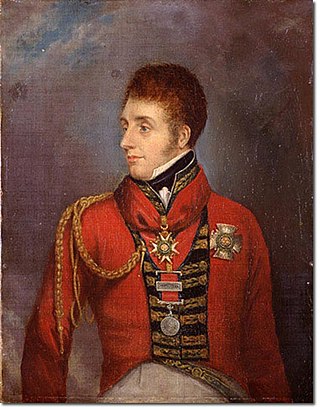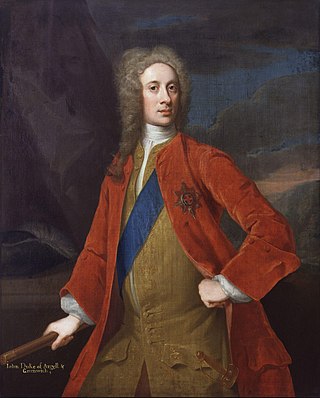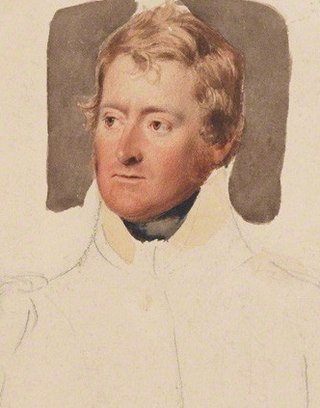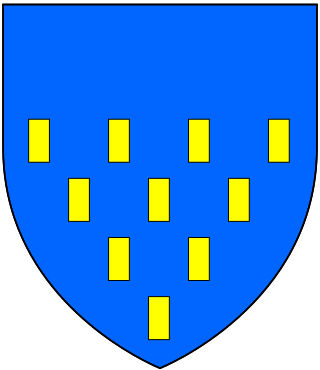Related Research Articles

Major-General Hon. Sir William Ponsonby was an Anglo-Irish politician and British Army officer who served in the Peninsular War and was killed at the Battle of Waterloo.

Field Marshal John Campbell, 2nd Duke of Argyll, 1st Duke of Greenwich,, styled Lord Lorne from 1680 to 1703, was a Scottish nobleman and senior commander in the British Army. He served on the continent in the Nine Years' War and fought at the Battle of Kaiserwerth during the War of the Spanish Succession. He went on to serve as a brigade commander during the later battles of the War of the Spanish Succession. Next he was given command of all British forces in Spain at the instigation of the Harley Ministry; after conducting a successful evacuation of the troops from Spain, he became Commander-in-Chief, Scotland. During the Jacobite Rebellion, he led the government army against the Jacobites led by the Earl of Mar at the Battle of Sheriffmuir. He went on to serve as Lord Steward and then Master-General of the Ordnance under the Walpole–Townshend Ministry.

Richard Temple, 1st Viscount Cobham was a British soldier and Whig politician. After serving as a junior officer under William III during the Williamite War in Ireland and during the Nine Years' War, he fought under John Churchill, 1st Duke of Marlborough, during the War of the Spanish Succession. During the War of the Quadruple Alliance Temple led a force of 4,000 troops on a raid on the Spanish coastline which captured Vigo and occupied it for ten days before withdrawing. In Parliament he generally supported the Whigs but fell out with Sir Robert Walpole in 1733. He was known for his ownership of and modifications to the estate at Stowe and for serving as a political mentor to the young William Pitt.

Major General Hon. Sir Frederick Cavendish Ponsonby was an Anglo-Irish military officer.

The 5th Dragoon Guards was a British army cavalry regiment, officially formed in January 1686 as Shrewsbury's Regiment of Horse. Following a number of name changes, it became the 5th Regiment of Dragoon Guards in 1804.

James Dormer (1679–1741) was a British Army officer, a lieutenant-general, and colonel of the 1st troop of Horse Grenadier Guards
Charles Ross was a Scottish general and Member of Parliament.

Charles Cathcart, 8th Lord Cathcart was a British Army officer. Before 1732 he was known as The Honourable Charles Cathcart.
General Sir Philip Honywood KB was a British Army officer.
Lieutenant-General John Brown was a British Army officer.

Brigadier-General Thomas Paget was a British Army officer and politician who sat in the House of Commons from 1722 to 1727. He was the ancestor of the Paget family, Marquesses of Anglesey.
Brigadier-General William Newton was an officer of the British Army.
Lieutenant-General Edward Pole was an officer of the British Army.
Lieutenant-General John Folliot or Folliott was an officer of the British Army.
Lieutenant-General Thomas Howard was an officer of the British Army and the ancestor of the family of the present Earls of Effingham.
Major-General John Moyle was an officer of the British Army.
Lieutenant-General Thomas Meredyth or Meredith, of Chelsea, Middlesex, was an Irish officer of the British Army and a politician who sat in the Parliament of Ireland from 1703 to 1719 and as a Whig in the British House of Commons from 1709 to 1710..
Sir James Leslie or Lesley was a British army officer of the seventeenth century.
Colonel Sir Robert Douglas of Glenbervie, 3rd Baronet was a Scottish soldier.
Lord Mark Kerr was a Scottish-born professional soldier, who served in the War of the Spanish Succession and the War of the Quadruple Alliance. He reached the rank of General in the British Army, and held a number of important administration posts, including Governor of Edinburgh Castle.
References
- 1 2 3 4 5 6 7 8 Richard Cannon, Historical Record of the Seventh, or Princess Royal's Regiment of Dragoon Guards (1839) p. 82.
- 1 2 3 4 Charles Dalton, English Army Lists and Commission Registers 1661–1714, volume IV (1898) p. 12.
- ↑ Dalton, English Army Lists, vol. V (1902) p. 33.
- ↑ Dalton, vol. V, p. 111.
- ↑ Dalton, vol. V, p. 159.
- ↑ Dalton, English Army Lists, vol. VI (1904) p. 299.
- ↑ Dalton, vol. VI, p. 18.
- ↑ Dalton, vol. VI, p. 144.
- ↑ Dalton, vol. VI, p. 31.
- ↑ Dalton, vol. V, Part II, p. 22.
- ↑ "No. 6371". The London Gazette . 8–11 May 1725. p. 1.